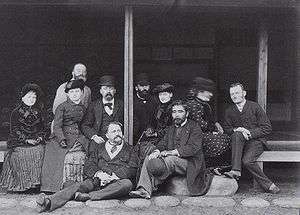Saigō Jūdō
| Marshal-Admiral The Marquis Saigō Jūdō | |
|---|---|
 Japanese General and Admiral Marquis Saigō Jūdō | |
| Born |
June 1, 1843 Kagoshima, Satsuma, Japan |
| Died |
July 18, 1902 (aged 59) [1] Tokyo, Japan |
| Allegiance |
|
| Service/branch | |
| Years of service | 1869–1902 |
| Rank | General and Marshal Admiral |
| Battles/wars | |
Marshal-Admiral The Marquis Saigō Jūdō (西郷 従道, also read Saigō Tsugumichi) (1 June 1843 – 18 July 1902) was a Japanese politician and admiral in the Meiji period.[2]
Biography
Early life
Saigō was born in Shimokajichō, Kagoshima, the son of the samurai Saigō Kichibe of the Satsuma Domain. His siblings included his famous older brother Saigō Takamori. Saigō changed his name many times throughout his life. Besides the two listed above, he sometimes went by the nickname "Shingō". His real name was "Ryūkō", or "Ryūdō". It is possible that he went by the name "Ryūsuke".
(After the Meiji Restoration, Saigō went to a government office to register his name. He intended to register orally under his given name Ryūkō (alternately Ryūdō). However, the civil servant misheard his name and he therefore became Jūdō (従道) under the law. He did not particularly mind, so he never bothered to change it back. The name "Tsugumichi" arose as an alternate pronunciation for the characters of his name.)
At the recommendation of Arimura Shunsai, he became a tea-serving Buddhist monk for the daimyo of Satsuma, Shimazu Nariakira. After he returned to secular life, he became one of a group of devoted followers of Arimura. As a Satsuma samurai, he participated in the Anglo-Satsuma War. He later joined the movement to overthrow the Tokugawa shogunate.[2]
He was a commander of the Satsuma army fighting in the Battle of Toba–Fushimi as well as other battles on the imperial side of the Boshin War.
Imperial Japanese Army
In 1869, two years after the establishment of the Meiji government, Saigō went to Europe with General Yamagata Aritomo to study European military organizations, tactics and technologies. After his return to Japan, he was appointed a lieutenant-general in the new Imperial Japanese Army. He commanded Japanese expeditionary forces in the Taiwan Expedition of 1874.[2]

In 1873, his brother Saigō Takamori resigned from the government, over the rejection of his proposal to invade Korea during the Seikanron debate. Many other officials from the Satsuma region followed suit, however, Saigō Jūdō continued to remain loyal to the Meiji government. Upon the death of his brother in the Satsuma Rebellion, Saigō Jūdō became the primary political leader from Satsuma. In accord with the kazoku peerage system enacted in 1884, he received the title of count (hakushaku).[1]
Government official
Saigō held a string of important positions in the Itō Hirobumi cabinet, including Navy Minister (1885, 1892–1902).[2]
As Minister of Internal Affairs, Saigō pushed strongly for the death penalty for Tsuda Sanzō, the accused in the Ōtsu incident, and threatened Kojima Korekata should the sentence be more lenient.
In 1892, he was appointed to the Privy Council as one of the genrō. In the same year, he founded a political party known as Kokumin Kyōkai (国民協会, The People's Co-operative Party).[2]
In 1894, Saigō was given the rank of admiral, in recognition of his role as Navy minister, and his peerage title was elevated to that of marquis.[1]
In 1898, the Imperial Japanese Navy bestowed upon him the honorary title of Marshal-Admiral. The rank is equivalent to Admiral of the Fleet or Grand Admiral.

Personal life
Saigō’s former residence (once in Meguro, Tokyo) is registered as an Important Cultural Property by the Japanese government and is now at the Meiji-mura historical park outside of Inuyama, Aichi Prefecture. Saigō also owned a cottage in Yanagihara (present-day Numazu), Shizuoka Prefecture. Saigō Jūdō was the first person in Japan to own a race horse.
Gensui the Marquis Saigō died in 1902 and was buried in the Tama Cemetery in Fuchū in Tokyo.
Notes
References
- Craig, Albert M. (1961). Chōshū in the Meiji Restoration. Harvard University Press. OCLC 482814571.
- Dupuy, Trevor N. (1992). Encyclopedia of Military Biography. I B Tauris & Co Ltd. ISBN 9781850435693. OCLC 59974268.
- Jansen, Marius B.; Gilbert Rozman, eds. (1986). Japan in Transition: From Tokugawa to Meiji. Princeton University Press. ISBN 9780691054599. OCLC 12311985.
- Ravina, Mark (2003). The Last Samurai: The Life and Battles of Saigo Takamori. Wiley. ISBN 0471089702.
- Much of the content of this article comes from the equivalent Japanese-language Wikipedia article ja:西郷従道, retrieved April 6, 2006
External links
| Wikimedia Commons has media related to Saigo Judo. |
- National Diet Library. "Saigo, Judo". Portraits of Modern Historical Figures.
| Political offices | ||
|---|---|---|
| Preceded by none |
Minister of the Navy of Japan December 1885 – May 1890 |
Succeeded by Kabayama Sukenori |
| Preceded by Yamagata Aritomo |
Home Minister May 1890 – June 1891 |
Succeeded by Shinagawa Yajirō |
| Preceded by Nire Kagenori |
Minister of the Navy of Japan March 1893 – November 1898 |
Succeeded by Yamamoto Gonnohyōe |
| Preceded by Itagaki Taisuke |
Home Minister November 1898 – October 1900 |
Succeeded by Suematsu Kenchō |